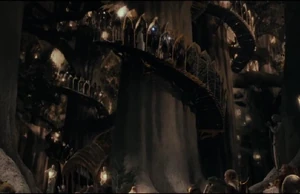
A mallorn in Lorien
The Mallorn (pl. mellyrn) was a kind of large tree that throughout history grew only in Aman, Númenor, Lindon, and Lórien in the Eastern lands of Middle-earth.
Description
Mellyrn were similar to beech trees in that their bark was smooth and silver-grey, but their leaves, which were green above and silver beneath, were much larger and longer than those of beech trees, and turned a clear gold in autumn. The golden leaves did not fall like those of other deciduous trees, but remained on the tree throughout the winter, falling only in the spring, when golden flowers bloomed on the branches and new leaves sprouted, turning the entire forest a bright gold. There is the sense that mallorn trees were more alive or had a greater presence than other trees. Frodo Baggins explained that he could feel the "life of the tree" when he touched a mallorn in Lothlórien.[1]
History
Mallorn trees originally grew on Tol Eressëa and probably also grew in Valinor.[2] The Ñoldor may have introduced mellyrn to Gondolin when they came to Middle-earth, but these were all destroyed with the city. The Elves of Tol Eressëa brought mallorn trees to the Men of Númenor, and they grew on the shores around the Bay of Eldanna in that land. Even Tar-Aldarion, the great Ship-King, did not cut down these trees.
Mallorn nuts were once given by Tar-Aldarion, a Ship-King of Númenor, to his friend Gil-galad, the Ñoldorin King of Lindon. The mellyrn did not grow in Lindon, but Galadriel took some nuts with her to Lothlórien, where they grew to immense heights. Lothlórien became known as the Golden Wood (the English translation) because of them.
The Fellowship spent its first night in Lothlorien on flets (wooden platforms) built onto the upper branches of several adjacent mallorn trees. In this case the flets were of simple construction with light, woven movable walls to block the wind. These mallorn trees were on the North Eastern edge of Lothlorien, close by the tributary river of Nimrodel or Silverlode.
Caras Galadhon, the city of Galadriel and Celeborn within Lothlórien, was built in the branches of huge mallorn trees, with a large hall built into the upper branches of the tallest tree at the centre of the city. The large horizontal branches of the mallorn lent themselves to being used in this way. The Fellowship were later given lembas, the elvish waybread wrapped in mallorn leaves.[1] The mallorn-leaf wrapping helped keep the waybread fresh and helped sustain its capacity to keep people alive for long periods in the absence of other foods.
Galadriel gave Samwise Gamgee a box of soil from her garden containing a single silver mallorn nut.[3] After the War of the Ring, Sam planted the nut in the Shire, in the Party Field where the Party Tree had stood. From the nut grew a new Mallorn tree that became the new party tree. It was the only mallorn tree in Middle-earth outside of Lórien. When the tree bloomed the next spring and summer it became the wonder of the neighbourhood and in time a place of pilgrimage; an image of times long past and a thing of beauty and wonder.[4] Symbolically, this specific tree acts as the living sign of the special blessing and thanks which the Shire receives for the efforts of Frodo, Samwise, Meriadoc and Peregrin in the struggle against Sauron and Saruman, as well as a nod to the essential and simple good qualities of the hobbit people and their close relationship to their lands.
Etymology
The name is derived from the Sindarin terms malt ("gold") and orn ("tree").
Malinornë is the Quenya name for Mallorn.
References
- ↑ 1.0 1.1 The Lord of the Rings, The Fellowship of the Ring, Book Two, Chapter VI: "Lothlórien"
- ↑ Unfinished Tales, Introduction, Part Two, I: "A Description of the Island of Númenor"
- ↑ The Lord of the Rings, The Fellowship of the Ring, Book Two, Chapter VIII: "Farewell to Lorien"
- ↑ The Lord of the Rings, The Return of the King, Book Six, Chapter IX: "The Grey Havens"
